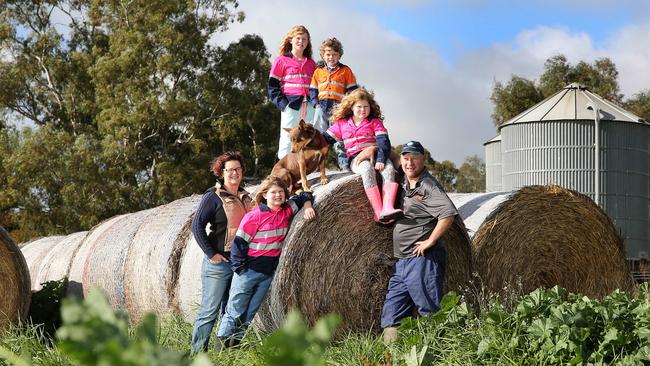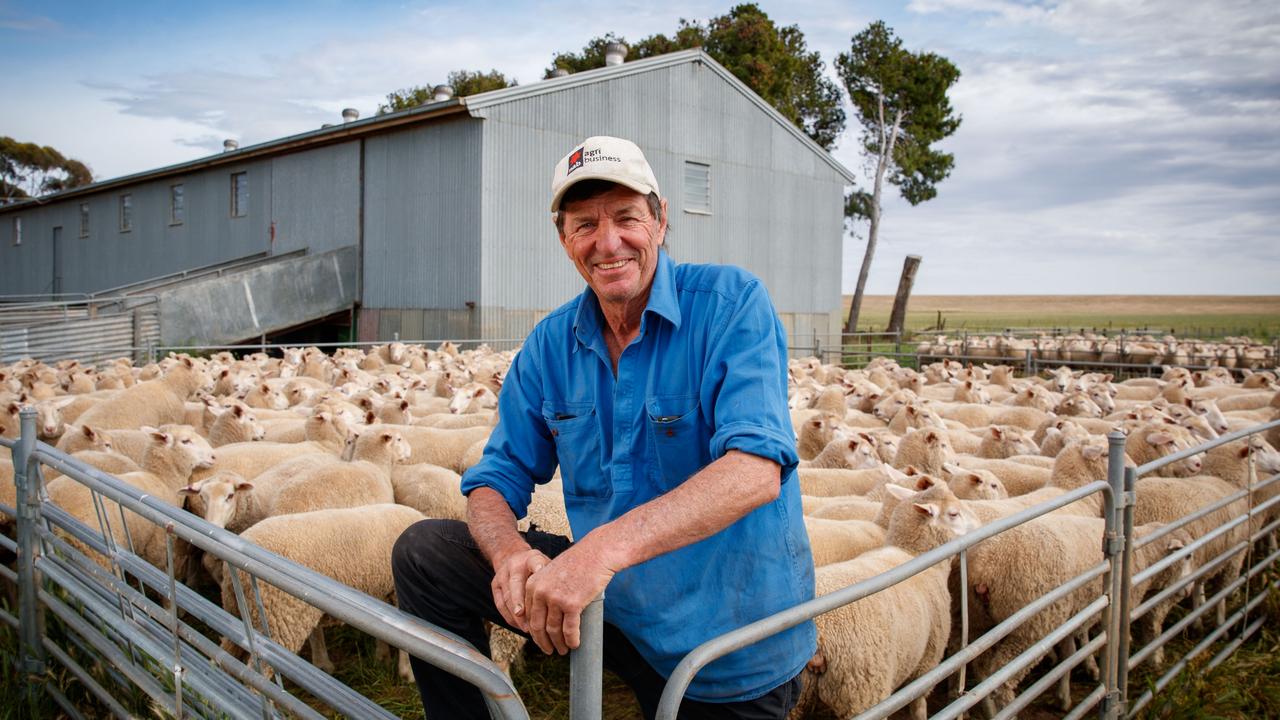Dairy farming: managing risk the key for Calivil’s Dehne and Sarah Vinnicombe
YEARS of farm data mean this dairy farming family always knows its options, writes SIMONE SMITH.

THE key to dairy farming is to not be in the market when everyone else wants or needs to be, Dehne Vinnicombe says.
It is also using the market — all markets — to the best of your ability.
For Dehne, his wife, Sarah, and his father, Ron, it’s as simple as that. Farming at Calivil, in northern Victoria, is all about managing risk.
The biggest risk for the Vinnicombe farm — water — is managed by producing as much feed from their available irrigation allocation as possible.
The risk of dry season is managed through large and varied fodder production and conservation — much of which is carried into the following season. Contracts are in place for those few inputs that can’t be sourced on-farm.
The family’s farmgate pricing risk had traditionally been managed by strict budgets, management of production costs as well as benchmarking within their local discussion group, which is driven by participants’ profit and loss statements and benchmarked against the dairy industry.
But, when processor Murray Goulburn cut its farmgate milk price in April last year, it was so late in the season the Vinnicombes had already made most decisions. It was then they were grateful to have years of farm data at their fingertips.
“If you have got those figures, year-on-year, and you have a build-up, you can make decisions on the run,” Dehne explained. “You know exactly what those figures are. We knew where we could cut back, where our strengths and weakness were.
“But by the time MG had done what they had done we had made most of our decisions.
“(For example) we had bought water (300 megalitres) carry forward already at $230 a megalitre — a high price to secure our water for the next season.”
The following season, they leased cows to make the most of low water prices and availability of feed in a bid to dilute costs low enough to try and remain under the farmgate milk price.
PITCH PERFECT
THE Vinnicombe family, including Dehne and Sarah’s children Hollee, 10, Macey, 9, Teagen, 6, and Henry, 5, milk up to 440 cows.
They say they are not wedded to Murray Goulburn going forward.
“We will probably go to the highest milk price, but we have looked at all options as we have been disappointed,” Dehne said.
“They (MG) may forgive us,” Dehne said of the phrasing MG chose when explaining to suppliers it would return controversial milk supply support package — better known as the clawback — money earlier this year.
“But I do not forgive them.”
It has been a tough year for the dairy industry, but for the Vinnicombes it has merely been a speed bump on their way to hitting future targets.
“It will be a catch-up year, I’m quite positive,” Dehne said about the next season.
With one of the best starts to the season “for a long time” in autumn, the family have a lot of ryegrass on their grazing platform, which they believe will carry them through until Christmas, with annual grasses petering out a little earlier.
“We’ve set ourselves up and next year will be a recovery year and we will just try and make as much money as we can,” Dehne said. “We are set, we didn’t sell too many cows, have 500 head of stock, 100 more than we need.”
POWER AND PASSION
FARMING has always been on the cards for Dehne.
“This is Grandma’s farm — (the family) has owned it since 1904,” he said of the 109ha home property. “I was always going to come to this farm ... then (after school) I started a dairy apprenticeship at Bendigo and then went overseas for 12 months, visiting the US, England, Italy, France, Ireland and working at the best farms. The highest producing farms — that was my education.”
Returning at 21, Dehne began sharefarming, before buying his aunt out up to six years later and forming a partnership with his father.
The family have sold bulls into artificial insemination programs, cows at International Dairy Week at Tatura and showed cows.
In the years that followed, drought “knocked us around a bit” before 2011 brought floods. A year later the family bought 219ha across the road. They also secured a “run-off farm” of about 243ha to cut fodder and grow crops. Another 283ha was purchased three years ago.
The farm is now a total 1012ha, 324ha of which is the home milking platform with the remainder of land for young stock and cropping.
The farm includes 85ha of lasered paddocks with 30-megalitre capacity channels and crossing at each bay outlet. “I believe land is undervalued in our area,” Dehne said. “It is cheap land, you get two acres of land for a megalitre of water.
“But it is one of our strengths out here, getting a return on assets as we do not have the capital growth compared to other regions.”
LEARNING CURVE
THE drought taught them to make the most of water — in essence mitigating risk.
“We’ve got a very large water right and we thought we needed to buy a few more farms just to spread our risk,” Dehne said. “It gave us a feed base to use.
We used whole crop silage and could mix canola meal. Also the transport costs and all other costs, the biggest killers, we didn’t have to worry about any of them because we had it all at home.”
“The reason we have bought these farms now is it gives us a larger area for every inch (25mm) of rain — you get so much extra feed,” Dehne said.
“But because water has been tight and water is our biggest risk. If you haven’t got water you haven’t got feed, it is as simple as that out here. If we have this large acreage we can irrigate it once or twice in the autumn, two or three times in the spring and that’s given us anywhere from 1.5 to 2.5 tonnes of dry matter per megalitre used. It then makes us become very efficient.”
Taking advantage of the cheap water market, the family has, in the past two seasons, grown large volumes and conserved “good” amounts of fodder. Dehne said conserving fodder as silage when the water market was cheap decreased production costs.
“We got down to as low as $96 a tonne dry matter for homegrown feed for (2014-15),” he said. “Do that and then put that away so you are out of the market when the market turns sour.
“If you can carry 1000 tonnes of silage over, 1000 bales of quality hay, that’s what we did last year. We carried a lot of fodder over so this year we are now growing a lot better fodder. All shaftal ryegrass rather than lucernes and cereals. We’ve put a lot more vetch in, so it will be premium quality hay.”
MEALS ON WHEELS
IN 2014-15 the Vinnicombes’ business was 93 per cent self-sufficient, buying in only canola meal and minerals. The cost of milk production that year was $4.07/kg of milk solids. With a drier year in 2015-16, they were about 80 per cent self-sufficient.
The cost of production that year was $5.15/kg of milk solids, including the 300 megalitres of carry-over water purchased at $230/megalitre as security. Costs that year also included more grain due to the dry conditions.
“We bought some almond hulls and stuff like that to dilute with the rest of our feed to keep us out of the market (last year),” Dehne said.
“We were paying $121 a tonne for that. Cereal hay was making $240/tonne. So I can feed two of that for a tonne of hay. Because we have the mixer wagon I could spread it out to make our own silage go further and then we ended up carrying hay over.”
The feed base is altered to suit the season, availability of water and weather conditions. The Vinnicombes don’t do a lot of summer crops but do grow lucerne and a little sorghum for the young stock.
“This year we have sown some annual pastures on the home farm because I believe we are going to be secure for water for the next three years. We will put a bit more lucerne in for summer feed, so we have put annuals in and they will come out in October and then we are straight onto the lucerne and away we go,” Dehne said.
“Not a big believer in carry-over water”, Dehne believes though if the rules are in place, they need to be made the most of. He is confident in water security for the next three years.
“The catchment is full now at 64 per cent and rising, we’ve stocked up our low reliability shares with carry over water,” he said.
“Water prices got low enough so we bought 700 megalitres to top up our low and put some into our high reliability account as well. This may allow us to grow maize, or something like that, for next year if grain gets too dear.”
LOCK AND KEY
LOOKING to the future with “feed up (their) sleeve” the family have been weighing up whether to build a new dairy or upgrade their feed pad. Their current 30 swing over with stall gates needs an upgrade but they are deciding between a double-up rapid exit or a rotary. The latter is more expensive but requires less staff.
With 60 per cent of the feed still direct grazed, the family say they need to maintain flexibility within their business to manage costs.
Their first capital investments would most likely be a feedpad upgrade and neck collars for the cows to monitor functions such as rumination and heat.
There’s no denying their love for dairy and the industry. The family are putting back in to the industry through involvement in Dairy Australia’s forage value index and Murray Dairy’s accelerating change program, which uses technology from a variety of agricultural businesses to bring back to dairy.
In equity terms, the family have increased their worth three times in the past five years. “We’ve been game though,” Dehne said. “We sold low reliability (water) for $300 a megalitre, bought permanent the same year for $1450 a megalitre and then bought low back for $240 a megalitre and today (last month) it’s worth $360 a megalitre. We sold an asset to buy another asset and then we paid most of this asset off.
“We are only as strong as the weakest link in our business, and if we can lift our weakest link we lift those things that makes us money- such as profit and return on assets.”


